|
 The Naval Air Station at Lakehurst, New
Jersey, was the venue for the 1953 aeromodeling "Nationals." Lakehurst was still
fresh in the minds at the time of everyone there because of the
Hindenburg Zeppelin
airship disaster that occurred a mere 16 years earlier (1937). All events, including
indoor, were flown at the same location thanks to the immense size of the field
and hangar. Those of us who have been in the the realm for a few decades will recognize
some of the names of folks in attendance. It's kind of sad to think that many of
the people captured in the photos here are gone from this Earth by now. Hopefully,
a family member or friend will find mention of them here and be given a chance to
enjoy seeing a picture that most likely have never been seen before. The Naval Air Station at Lakehurst, New
Jersey, was the venue for the 1953 aeromodeling "Nationals." Lakehurst was still
fresh in the minds at the time of everyone there because of the
Hindenburg Zeppelin
airship disaster that occurred a mere 16 years earlier (1937). All events, including
indoor, were flown at the same location thanks to the immense size of the field
and hangar. Those of us who have been in the the realm for a few decades will recognize
some of the names of folks in attendance. It's kind of sad to think that many of
the people captured in the photos here are gone from this Earth by now. Hopefully,
a family member or friend will find mention of them here and be given a chance to
enjoy seeing a picture that most likely have never been seen before.
The Nationals
 By Frank Zaic, Photos by Schoenfield By Frank Zaic, Photos by Schoenfield
It is only fitting and proper that the Nationals should begin with the indoor
event. This event has been with us since the Nationals began, and it is the only
one in which the models are not handicapped in fulfilling their basic function:
defying gravity for maximum possible time.

"Tennie" and the Nordic. Mrs. George Perryman launches husband's
Nordic glider which after meet went to Yugoslavia along with George to compete in
international event. His trip sponsored by Lockheed.

Tom Henebry (see "From the Reader" last issue) launches his elliptical
dihedral Half-A free flight. Tom is all-round builder, a CPO in the Navy from Chula
Vista, Calif. His designs were all finished beautifully.
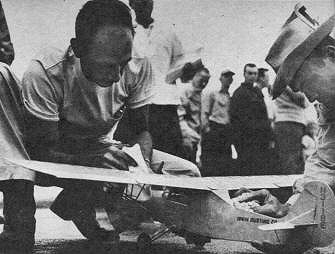
Two-time flying scale champ Thomas Dean of Corpus Christi (lt.)
dries off his Aeronca "duster" model. Power was Cameron .19. Everything works on
model including prop on duster bin, tiny seat belts, shock absorbers.

Winner of the Hiller Model Helicopter competition was Parnell
Schoenky of Kirkland, Missouri., who works for McDonnell Aircraft. His 121.41 points
put him for out in front. Dave Call, the meet official at left, handled event.
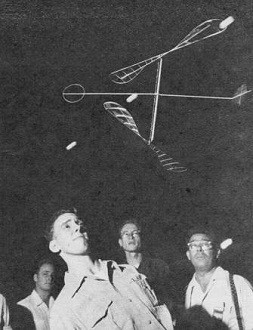
Dick Querman of Long Island City attempted to better the existing
record for indoor helicopters but missed the mark by a narrow margin. At right is
Jesse Bieberman of old Phila. Gas Model Assoc., who directed indoors.
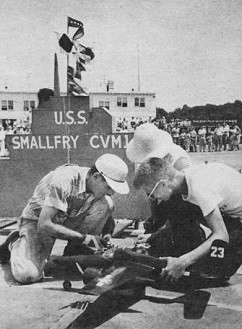
For carrier flying John Albertson (left) of Arlington, Va., entered
this F7F which used two K&B '32's. One engine cuts for low speed run and deck
landing. David Domizi, Rocky River" O., won with 391.5 points.

Airman 3/C Stuart Savage of Wright-Patterson AFB who shared senior
champ honors with Ron Plotzke of Detroit demonstrates the proper technique in indoor
H/L glider flying. He did 52.8; winner turned in 69.6.
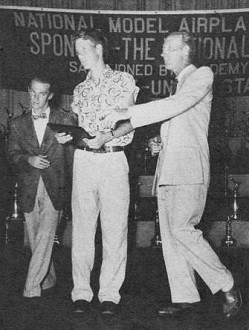
Dance of Victory... National champ Bill White gets his Exchange
championship plaque from contest director Matt Sullivan (right) while AMA president
Keith Storey looks as if he's cutting in for the next number.

Berni Schoenfield, the noted photographer and ex-modeler who
"covered" the Nats for "AT," was impressed by the minute size of the Half-A speed
entries. This one by USAF flyer Tommy Baker was among neatest.

Busiest man in free flight was the much beloved builder from
Topeka, Kan., C. O. Wright. Everybody wanted to talk to him (as did Ed Al Lewis,
left); then C.O. is shown with his Half-A "Spacer" ("built it just as Sal directed");
next PAA ("this is a design by Herb Kothe"); finally his Super Cruiser for the Half-A
flying scale event. His battery box has homemade voltage regulator.

Young Mister Wright

She went thataway - the wing, we mean. "Thataway" being backwards!
This sad episode was staged by Robert A. Jones of Norfolk, Va. Rubber band which
was holding wing at launch time is blurred streak.

Scale director Vic Fritz (lt.) and Ann Houze of Philadelphia.
MAA check over Thomas Dean's first place Aeronca crop duster. Al Rubin (rt.), one
of busiest officials, and Pete (Indoor Champ) Andrews also admire it.

Hal Roth of Richmond, California, who walked off with PAA Clipper
Cargo (lifting 23.25 oz. for 42 seconds with a Half-A engine) discusses the finer
points of his Wakefielder with Frank Zaic (it.), Nats "AT" reporter.
The event at the Lakehurst hangar seemed like a reunion of the indoor alumni
responsible for the development of indoor models as we know them. Some came as flyers,
others as spectators and officials. Among the flyers we found Bill Tyler who used
to represent Boston; John Zaic, New York Aeronuts; and Pete Andrews and Tony Becker,
Philadelphia. Jesse Bieberman had his old job as contest director with assist from
Mayhew Webster, Erv Leshner and others. If one could forget war years, wrinkles
and grey hairs, the event seemed more like one of the pre-war record trials at which
the records were pushed higher and higher from the reach of beginners.
Attending or competing in an indoor meet is an experience not easily forgotten.
Time seems stretched out, and the day never ends. It's almost like living in a fish
bowl. All motions are slow. Men on the bottom, or floor, move with a snail-like
pace, while the models just drift around and around. At this particular meet, Dick
Querman heightened the effect by flying his slowly moving helicopter.
Don't think excitement is lacking. As a model gradually spirals toward the treacherous
roof, one begins to anticipate the troubles it may encounter before it completes
its flight. Will it go up and down without touching the ceiling or sides? Or will
it be snagged when it is just about to break a record or beat the previous best
time? There are times when the model drifts toward the sides with each succeeding
circle bringing it closer to disaster. If you want suspense, watch an indoor model
working gradually to the sides. You can see it pass the girder with twelve inches
to spare. Then you have to wait 30 seconds before it gets around in its deliberate
circle... Somehow, an indoor model gets your sympathy, and it is not uncommon to
have spectators shout warnings to the model to "keep away."
Pete Andrew's Class D, 300 sq. in. "stick" was the prima donna. Pete played safe
and started his official flights with 1400 turns, and got around 25 min. The ship
looked so good that he threatened to put it away for future record trials, but the
rest of the boys were pushing, the time up, and he had to try again, with more turns.
Somehow he managed to keep his model below the rafters and side girders during his
three official flights. But on the very next flight, which was intended for record,
his luck ran out and the model drifted to the sides.
Before the microfilm models started to fly at 11 a.m., the hand-launch gliders
filled the air. (Incidentally, the first official flight of the meet was made by
Fred Salmon of Keesler AFB at 9:35 in the glider event). While Carl Rambo from California
was working up toward his 1 min. 7 sec., Ed Luca of Brooklyn was exhorting his fellow
Skyscrapers to try their best to keep the honors in the East. When the morning session
ended Rambo led with 1 min. 7 sec., but when glider flying resumed after 5 p.m.
William Dunwoody of the Skyscrapers pulled a "Dodger" with 1 min. 9 sec.
The opening day can be taken as good indication of how the rest of the week shaped
up organization-wise. It was a pleasant surprise to see the timers and tents ready
,to operate. at 9 a.m. There was no time-consuming opening ceremony which usually
distracts everyone from his job. As quickly as the flight lines formed, the timers
chopped them up. Processing during the previous evening eliminated all but weight
and stamp mark checking. At no time during the entire meet did one see a bottleneck.
If you were ready, a timer was just a few minutes away - ready, willing and able.
Unfortunately, the opening day also showed how limited the field was for retrieving.
A fair drift would take your model beyond the fenced boundary. You may have clocked
six minutes maximum, but your model was gone, D/T'ing over brush or residential
area. The Navy helicopter and cooperative phone calls plus prompt pick-up service
brought many models back for another try, but many were lost or retrieved too late
for that day's flying. The Easterners are used to such conditions, and the Westerners
were good sports about it. The Navy did its best and no one could ask for more.
Since it would take a long article to describe individual events, max by max,
crash by crash, and day by day, it seems best to give our personal impression of
events so that those of you who were too busy in your own private corner might get
an idea of what went on in general, while the stay-at-homers can realize they missed
a good thing.
After all these, years of 100-foot tow lines and tight-turning gliders, the Nordics
presented a different picture as they were towed up to the peak of 320 feet (about
30% made it) and then glided in rather large meandering circles. Since most of them
had sharp tip dihedral, we could not help but compare them with the Balinese dancers
with their outstretched arms and upward-pointing fingertips. And the Nordics looked
just about as graceful, if you go for that sort of dancing, in contrast to the gull-like
wheeling of the old-type gliders we used to watch spiral upward. Since the day was
not exactly thermal, we can't say how the Nordics would react to real thermal flying.
Near the Nordic take-off site the Wakefield boys had their day. As many of you
may know, this is the last year in which there is no limit to the amount of rubber
that can be used in the model. (Next year, only 2.8 oz. can be used.) And so, the
ratio of rubber to total weight was carried to the extreme by many. A 3 oz. model
with 5 oz. of rubber was nothing special. In effect, it's like having a 1000 hp
engine in a Piper Cub.
The official Wakefield event was held during the day, but the unofficial Wakefield
Team event was flown during dawn; it was won by the Detroit team.
A bit further down the line. the gas-powered flyers had their fun. This type
of flying can be likened to a thunderstorm cloud. Looking at it from a distance
you see occasional lightning in it and hear a bit of thunder - on the whole it seems
harmless enough. But if you had to fly through such a cloud your impression would
be quickly changed by the violence inside. And so it is when you walk into free
flight during the Nationals when every timer is on the firing line. It makes no
difference what class of engines is gobbling up the gas, the excitement and high
tension edge your nerves. You have no chance to have a quiet talk or even think.
Your faculties are tuned to nothing but self-preservation. One has to keep his eyes
on dozens of take-offs and make split-second decisions which way to duck. In fact,
the action is much too fast to feel sorry for the sad cases. After a while one gets
a peculiar sadistic feeling in waiting for a real honey of a splash.
The mortality of the free flight models seems to average about 50% or more. If
the splashes were not absolute, the engine just cut out in time. (Can't vouch for
the rumor that the timers were giving themselves "Ace" rating after timing five
"splashes.") There were a lot of screaming, almost straight-up flights to show the
boys that it could be done.
The "National" atmosphere is very catching. It gives the contestant a feeling
that by merely being at the big meet, his models acquire unique properties they
did not have at home.
With thunder and lightning diminishing in the free flight area, we drifted to
the "country club set" where the radio control flyers were going through their tasks.
From the outward appearance, the R/C event is ideal. Only one or two models can
be in the air at the same time, and no testing is allowed. This sort of a thing
gives the boys a lot of time to gossip and visit, which after all is one of the
most important things to do at the Nationals - digging up secret information with
which to "kill" the boys back home.

Sol (Spacer Chaser) Taibi, once of Brooklyn, now proud of his
adopted California, demonstrates proper rise-off-water technique. Mrs. T. keeps
her fingers crossed (lt.). Sol racked up top time in this category - 13:00.5.

No, this is not the ROW tank! Just a rainy runway scene last
day of contest. Air Force's Al St. Clair of Williams AFB readies his "Neptune" free
flight. He couldn't have picked a better name considering weather.

Neat carrier take-off by Vincent Calano's AD-2 (from "AT" plans).
Used Fox .35 with intake butterfly choke for engine control. Hez from Hartford,
Conn. Event drew crowd. Nat. champ White won junior ABC carrier.

One of the nation's top model designers, Lawrence Conover from
Iowa City, Iowa, goes after the ornithopter record. Special attempts at records
were permitted throughout meet; the modeler really was king.

Merrick S. "Pete" Andrews of New York City with his big Class
D 30:15.5 microfilm-covered stick model, high timer of indoor events. "AT's" Bill
Tyler readies his Class B job (rt.). Andrews is world's finest "mike" man.

Half-A flying scale champ Edward Stoll of Detroit testing his
Fairchild 24, a modified Berkeley design. Ed's 290.22 points were more than 100
ahead of next contender. Wasp .049; event was flown ROG in drizzle.

Henri Dore adjusts dethermalizer of his Nordic glider. After
contest model was shipped to Yugoslavia to be flown by proxy in international A/2
contest. Jasco's John Zaic (rt.) helps while brudder Frank holds line.
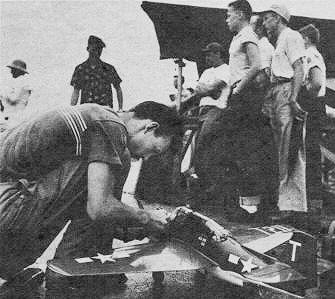
Grumman Avenger entered in flying scale event by Robert Fritsch,
Camden, N. J. Number of entries in this event was less than in '52 despite change
in rules which eliminated stunt and required only 10 laps by each man.

And away she goes - or, look, Ma, no hands! Bill Fletcher shows
how to get a Wakefield off accordin' to the rules. Fletcher left Nats for England
where he served as captain for U. S. group, which won team honors.
Posted May 2, 2015
|